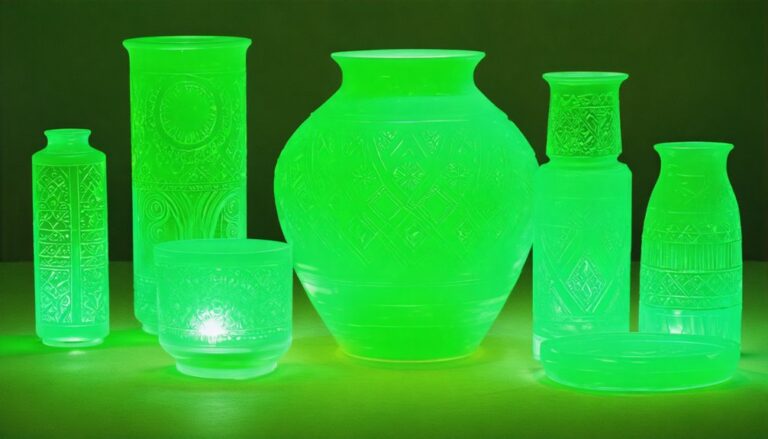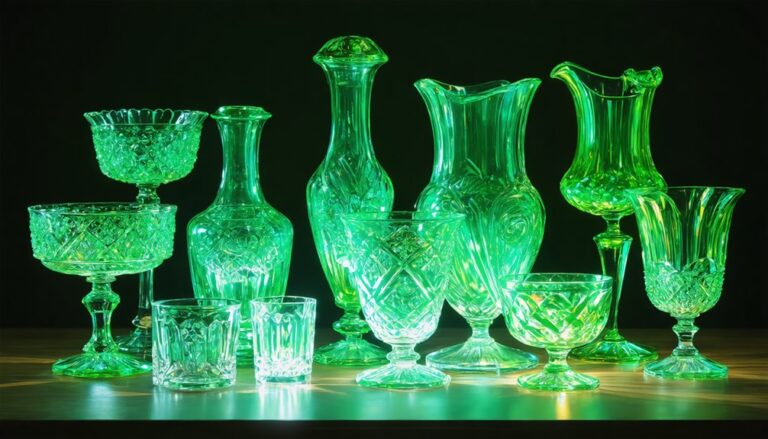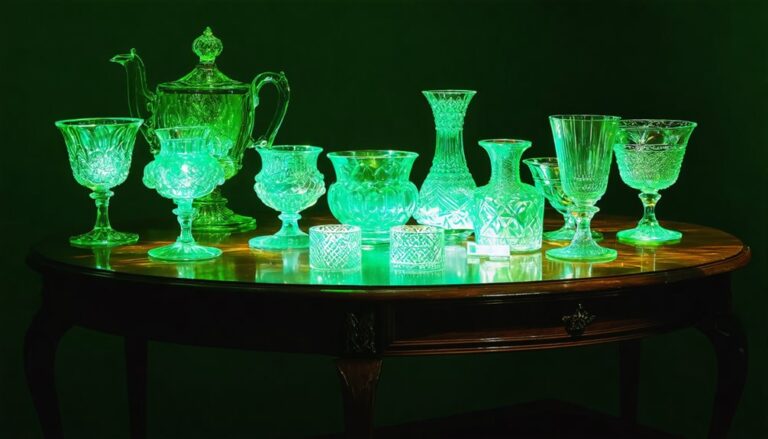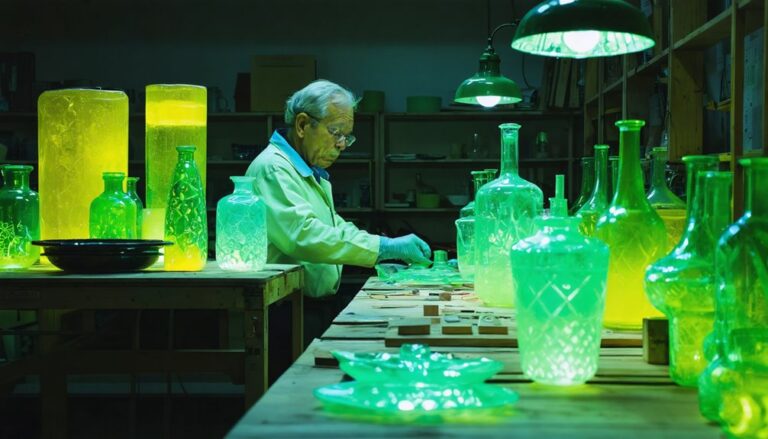The Role of Uranium Glass in 19th Century Tableware
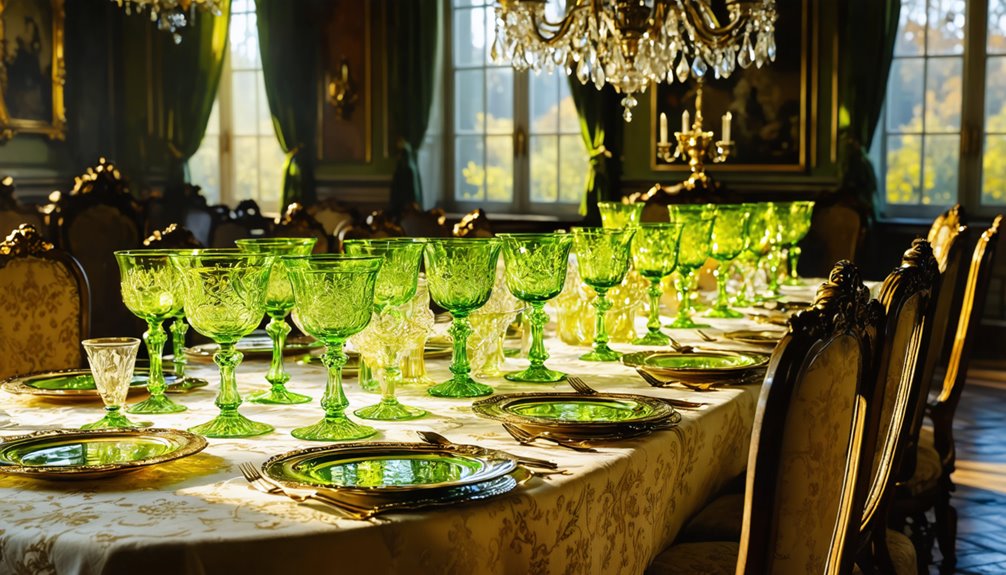
Uranium glass, also known as Vaseline glass, played a significant role in 19th-century tableware. It is famous for its bright yellow-green hues and fascinating luminescence. Artisans created this glass by adding uranium oxide to molten silica. The result was a material that not only looked striking but also glowed under ultraviolet light.
Victorian families valued uranium glass for both its beauty and functionality. They used it for various tableware items, including elegant dishes, goblets, and serving trays. This glassware symbolized sophistication and the scientific advancements of the time.
Collecting uranium glass has become a popular hobby for many. Enthusiasts are drawn to its unique glow and historical relevance. Museums and exhibitions often showcase these pieces, highlighting their craftsmanship and the innovative methods used in their creation. The allure of uranium glass continues to captivate those who appreciate art, science, and history.
Key Takeaways
Uranium glass, known for its striking yellow-green glow, became a popular choice for tableware in the 19th century. Many households embraced this unique glassware, drawn by its ability to enhance the dining experience. The luminous quality of uranium glass added a touch of elegance to the table setting.
During the Victorian era, people showcased uranium glass items like beautifully crafted bowls, goblets, and dishes. These pieces weren’t just practical; they also served as artistic decorations. The blend of usability and beauty appealed to the tastes of the time, making uranium glass a staple in many homes.
This type of glassware represented a blend of innovation and sophistication. It connected the scientific advancements of the era with the Victorian love for decorative art. Households in both Europe and America enjoyed uranium glass, as it made social gatherings more special. The unique visual appeal of these items often sparked conversations among guests.
At the time, people had limited understanding of radioactivity. As a result, uranium glass was viewed as safe, and concerns about health risks were largely absent. This lack of awareness contributed to its widespread acceptance and use in everyday life.
Origins of Uranium Glass in Tableware Manufacturing
In the 1830s, Josef Riedel introduced uranium glass, making a noteworthy impact on tableware manufacturing. This unique glass quickly gained popularity, especially during the Victorian era. People were drawn to its decorative charm and elegance.
The vivid yellowish-green color, known as Vaseline glass, came from uranium dioxide. This ingredient not only created striking colors but also made the glass glow under ultraviolet light, which fascinated the Victorians.
Vaseline glass’s captivating yellow-green glow, sparked by uranium dioxide, enchanted Victorians, revealing its luminous charm under ultraviolet light.
As interest in uranium glass grew, manufacturers recognized its allure. The Whitefriars Glass Company in London was one such company that saw the potential.
By the 1880s, production of uranium glass tableware soared. This trend connected families and friends, bringing warmth and beauty to their dining experiences.
The early uses of uranium glass symbolize a time when innovation and style transformed everyday life.
Uranium Glass Crafting Techniques of the 19th Century
Uranium glass, often called Vaseline glass, became popular in the 19th century. Skilled artisans made this unique glassware by mixing silica, soda ash, and uranium oxide. The blend gave the glass its distinctive glowing green color, which fascinated many people.
Artisans used traditional glassblowing methods along with specialized molds to create beautiful forms. They shaped the molten glass with great care, showing off their talent and creativity.
After shaping, cooling was essential. Controlled annealing helped stabilize the glass, ensuring it would last for years.
Uranium glass wasn’t just decorative; it served practical purposes, too. People used it for everyday tableware, adding a touch of elegance to meals.
Its glow under UV light made it a favorite among collectors today, showcasing the blend of art and science in the early uses of uranium glass.
Glassblowing and Uranium Mix
Uranium glass, often called Vaseline glass, has an intriguing history. In the 19th century, artisans created this unique type of glassware by mixing uranium oxide into the molten glass. The result was a striking fluorescent green glow that captured the attention of many.
Artisans used materials like silica sand, soda ash, and limestone in the crafting process. Silica sand formed the strong base of the glass, while soda ash and limestone helped stabilize and clarify the mixture. This careful balance of ingredients was crucial. It turned ordinary glass into something extraordinary, making it a favorite in Victorian homes.
People valued uranium glass not just for its beauty but also for its uniqueness. It became a symbol of elegance and sophistication. Collectors sought after these glowing pieces, which often adorned tables and display cases.
In this way, uranium glass became more than just tableware. It represented a blend of artistry and innovation, showcasing the skill of glassmakers. Over time, these vibrant pieces transformed into cherished heirlooms, reflecting a fascinating chapter in the history of glassmaking.
Shaping and Cooling Methods
In the 19th century, artisans had a strong appreciation for precision and elegance. Shaping uranium glass required skill and a keen eye. When the molten uranium glass was ready, I’d carefully gather it onto a blowpipe. With gentle movements, I’d shape this glowing liquid into beautiful decorative pieces, such as ornate vases or fine stemware.
Sometimes, I’d use molds to create intricate patterns, which were especially popular during the Victorian era.
Cooling the glass was just as important as shaping it. I’d use a method called annealing. This process involved slowly cooling the glass to minimize internal stresses. By doing this, the uranium glass developed its stunning translucent qualities and vibrant colors.
These features made it highly sought after by collectors and enthusiasts. As a result, uranium glass found a cherished place in Victorian homes and tableware collections, reflecting the artistic spirit of the time.
Distinctive Colors and Characteristics of Uranium Glassware
Uranium glassware has a fascinating history, especially during the Victorian era. People loved its bright green glow when viewed under ultraviolet light. This glow comes from uranium oxide mixed into the glass. The glass can show different shades, from light greenish-yellow to deep lime tones. Collectively, this type of glass is known as “Vaseline glass.”
The unique glowing effect made uranium glass a hit in 19th-century homes. It attracted collectors and decorators alike. Many used it to add a touch of color to their homes. This glass wasn’t just pretty; it was also a conversation starter. People were drawn to its unusual characteristics and vibrant hues.
Initially, uranium glass was used for practical items like dishes and bowls. Over time, it became more decorative. Artisans enjoyed crafting it into beautiful shapes and designs. This blend of functionality and artistry helped uranium glass gain popularity.
It stands out in glass history for its distinctive features.
Vintage Glow Under UV
Uranium glass has a fascinating history that dates back to the 19th century. This unique glass, often known for its vibrant green glow, contains small amounts of uranium. It was popular during a time when people were intrigued by the new materials and technologies of the industrial age.
In the early days, uranium glass was used to create various items, from plates to goblets. These pieces weren’t only functional but also served as decorative objects. The captivating fluorescence under ultraviolet (UV) light was a delightful surprise for many. It added a special charm to dinnerware and showcased the craftsmanship of the era.
The uranium content in these glass pieces varies, typically ranging from trace amounts up to 2%. This small percentage is what contributes to their unique glow. Collectors often seek out these items because of their distinct characteristics. The UV fluorescence serves as an indicator of authenticity, helping buyers identify real uranium glass from modern reproductions.
Over time, the value of uranium glass has increased. Its historical significance and unique properties make it a prized possession for collectors. The allure of this glass lies in its connection to the past and the stories it carries. Each piece offers a glimpse into the creativity and innovation of the 19th century.
Today, enthusiasts continue to cherish these remarkable artifacts. The glow of uranium glass under UV light not only captivates the eye but also sparks curiosity about its history and early uses.
Popular Glass Color Shades
Uranium glass, often called Vaseline glass, is famous for its pale yellow to green color. But there’s much more to this intriguing glass. Collectors look for a variety of colors and features. One of my favorites is custard glass. It has a soft, milky-white appearance. This makes it ideal for decorative items like dishes and bowls.
Another interesting type is jadite. This glass has a solid, muted green color. Collectors love it not just for its beauty but also for its glow under ultraviolet light. Manufacturers like Whitefriars and Fenton Glass used different metal ions in their production. This created unique colors and clear transparencies. Because of these efforts, vintage uranium glass is still in high demand among collectors today.
Historically, uranium glass had practical uses too. In the 19th century, it was popular for making tableware and decorative pieces. Its unusual colors and ability to fluoresce made it a conversation starter. People enjoyed showcasing it in their homes.
Over time, its popularity faded, but today, it has found a new audience. Collectors appreciate its history and craftsmanship. This glass tells a story, connecting the past with present enjoyment.
Popularity and Spread of Uranium Glass Across Europe and America
Uranium glass came into the spotlight in the 1830s. Many people didn’t foresee how quickly it would capture the European and American markets. This glass became a favorite in Victorian homes. Its bright yellow-green color was a bold change from the usual tableware shades. This unique look made it highly sought after.
In Europe, the Whitefriars Glass Company was a pioneer. By the 1880s, they started mass-producing uranium glass pieces. This move helped fuel its popularity. The glass glowed under ultraviolet light, and this enchanting feature drew many buyers. Soon, the demand reached North America. There, households embraced uranium glass, often called “vaseline glass.” They wanted a special style that made their dining tables stand out.
Uranium glass was more than just a trend. It linked families in the Victorian era across both continents. People cherished its beautiful design and fresh appeal for tableware and décor.
From intricate dinner sets to eye-catching centerpieces, uranium glass became a symbol of elegance and creativity in homes.
Prominent Manufacturers and Makers of Uranium Glass Tableware
Uranium glass tableware has a rich history marked by notable manufacturers. Josef Riedel invented uranium glass in the 1830s. His Annagruen and Annagelb pieces became popular for their unique colors and designs. This marked the beginning of a new era in glassmaking.
In the 19th century, the Whitefriars Glass Company in England, founded by James Powell, played a significant role. They mass-produced uranium glass tableware, making it accessible to many homes. Their innovative techniques helped popularize this vibrant glass.
Baccarat Glassworks from France also made a name for itself. They created elegant and high-quality uranium glass pieces that showcased fine craftsmanship. Their work is still highly regarded today.
In the early 20th century, American companies like Fenton Art Glass Company emerged. They produced colorful and intricately designed uranium glass items. Their creations captured the attention of collectors, further boosting the popularity of uranium glass.
| Manufacturer | Notable Contributions |
|---|---|
| Josef Riedel | Invented uranium glass, Annagruen pieces |
| Whitefriars Glass Company | Mass-produced uranium glass tableware |
| Baccarat Glassworks | Elegant, high-quality uranium pieces |
| Fenton Art Glass Company | Colorful, intricate designs from the early 1900s |
Uranium glass has fascinated collectors and enthusiasts alike. Its unique glow and vibrant colors have made it a sought-after item. The legacy of these manufacturers continues to influence the world of glassware today.
Decorative Styles and Patterns Commonly Used With Uranium Glass
Uranium glass tableware from the 19th century shows two distinct decorative styles.
On one hand, we’ve the elegant Victorian floral motifs. These pieces often feature intricate blossoms and natural shapes. They reflect the delicate beauty that was popular during that era.
On the other hand, Art Deco designs took a different approach. This style emphasized bold symmetry and geometric shapes. You’d see sharp lines and angles in these pieces. They brought a modern touch to the vibrant glass, showcasing a new aesthetic that appealed to the changing tastes of the time.
Both styles highlight how uranium glass wasn’t just functional but also a canvas for artistic expression.
The use of uranium in glassware added a unique glow, further enhancing its decorative appeal. This combination of beauty and science made uranium glass a fascinating part of the tableware history.
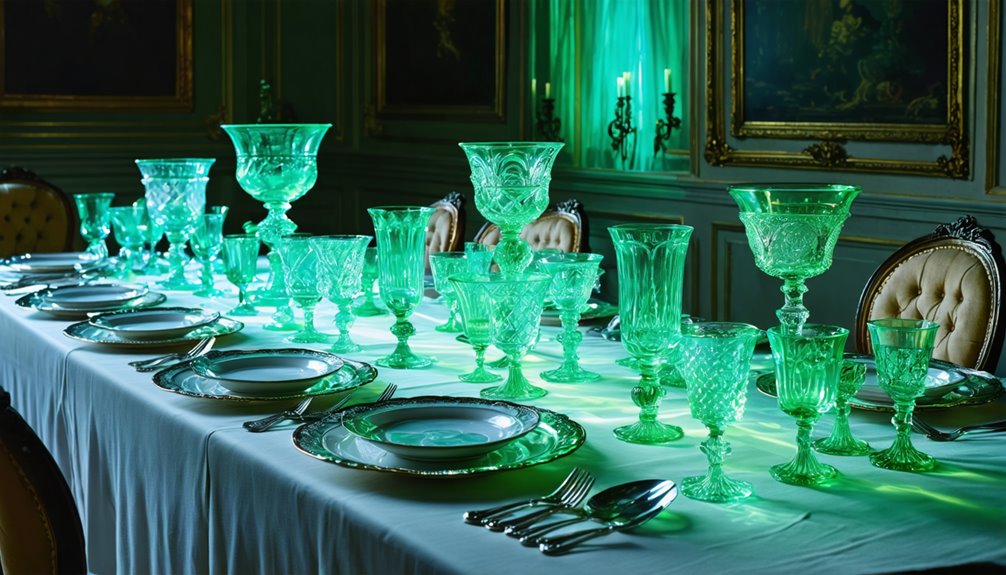
Victorian Floral Motifs
Uranium glass, also known as Vaseline glass, has a rich history that dates back to the early 19th century. This glass contains small amounts of uranium, which gives it a distinctive yellow-green glow under ultraviolet light. Early uses of uranium glass weren’t just practical; they were also decorative.
Victorian artisans were particularly fond of floral motifs. They often created beautiful designs featuring flowers like daisies, roses, and forget-me-nots. These patterns were more than just decoration; they held symbolic meanings. Daisies represented innocence, roses signified love, and forget-me-nots stood for remembrance.
The unique glow of uranium glass combined with these intricate floral designs made each piece stand out. Many glassmakers layered clear and colored glass to enhance depth and beauty. This technique, known as cased glass, added visual interest to the pieces.
Collectors today highly value these decorative items. The floral motifs reflect the Victorian era’s appreciation for nature and beauty. They also highlight the importance of domestic life during that time. As a result, uranium glass with floral patterns holds both aesthetic and historical significance.
Geometric Art Deco Designs
Uranium glass has a fascinating history. Its early uses date back to the 1830s, when glassmakers discovered that adding uranium oxide to glass created a beautiful green hue. This glass, often called “Vaseline glass,” was popular for its unique color and its ability to fluoresce under ultraviolet light.
In the 1920s and 1930s, the Art Deco movement brought a new wave of creativity. Designers embraced geometric shapes and bold lines. Uranium glassware became a canvas for these striking designs, featuring sharp chevrons and precise zigzags.
This combination of vibrant colors and the glass’s distinctive glow made tableware pieces truly stand out. Prominent manufacturers like Fenton and Cambridge recognized the trend. They produced elegant vases, serving dishes, and stemware that weren’t only functional but also artistic.
Today, owning these pieces connects people to a rich history of craftsmanship and design. Uranium glass is more than just decorative. It tells a story of innovation and style during a vibrant era. Its unique properties and design make it a cherished collectible for many.
Household Uses and Types of Uranium Glass Objects
Uranium glass, often referred to as vaseline glass due to its unique yellowish-green hue, played a practical role in 19th-century homes.
This glassware was more than just a decorative item; it was a cherished part of dining and home decor. Many households featured beautiful tableware made from uranium glass, showcasing its fascinating fluorescent qualities. The distinct glow of yellow-green vaseline pieces added a touch of elegance to family gatherings, reflecting a sense of style and refinement.
Common household items made from uranium glass included:
- Ornate bowls adorned with intricate patterns.
- Goblets used for everyday meals.
- Dishes and platters with exquisite designs.
These items weren’t merely collectibles; they fostered a sense of community and belonging in homes across the era.
Uranium glass was a testament to the creativity and craftsmanship of the time, merging functionality with beauty. Families appreciated these luminous pieces, making them a staple in both dining and decoration.
Cultural Significance and Symbolism of Uranium Glassware
Uranium glass, often called vaseline glass, has a rich history that goes beyond its practical use or decorative appeal. These unique glass pieces first gained popularity in the mid-19th century, during the Victorian era. They symbolize a fascinating blend of art and science, showcasing the innovative spirit of the time.
The glass contains a small amount of uranium, which gives it a striking yellow-green hue. When exposed to ultraviolet light, it emits a vibrant fluorescence, making it visually captivating. At social gatherings, these items became fashionable conversation starters, reflecting a host’s sophisticated taste.
Owning uranium glass was a sign of status, especially for the growing middle class. People wanted objects that weren’t only beautiful but also represented the scientific advancements of the era. This glassware appealed to those who valued creativity and progress, blending aesthetics with a touch of the scientific curiosity that defined the Victorian age.
Even today, uranium glass carries cultural significance. It serves as a testament to a time when the boundaries between art and science blurred. Collectors and enthusiasts continue to appreciate these pieces, keeping the spirit of innovation alive while celebrating the unique charm of this extraordinary glassware.
Impact of Uranium Availability on Glassware Production
When uranium became easier to find in the 1880s, glassmakers jumped at the chance. This led to a burst of bright and colorful tableware and decorative pieces. The Whitefriars Glass Company, among others, creatively used uranium’s glowing properties. They made unique glass items that appealed to homemakers looking for something special.
But the supply of uranium didn’t stay steady. During World War II, uranium was needed for the Manhattan Project. This shift caused a sharp decline in the production of uranium glass.
After the war, getting uranium became harder again. This led to fewer types and less quantity of glass being made.
The long shortage of uranium from the 1940s to the 1990s made vintage uranium glassware rare. Today, collectors search for these authentic historical pieces. They appreciate the beauty and uniqueness of uranium glass, making it highly sought after in the market.
Safety Awareness and Early Health Perceptions of Uranium Glass
In the 19th century, uranium glass captivated many with its vibrant glow. People didn’t worry about safety risks. They saw it as a beautiful addition to their homes. Back then, knowledge about radioactive materials was limited. Few understood the dangers of radiation exposure. Safety standards weren’t strict, so uranium glass was thought to be harmless.
During this time, uranium glass gained popularity for its decorative appeal. People embraced it confidently, believing the risk was minimal. They used it in tableware and other household items without hesitation.
Today, we know that uranium glass contributes only 1-2% to an average American’s annual radiation exposure. This amount is much lower than what comes from everyday objects. But in the past, awareness of these facts was absent.
Today, we realize uranium glass’s radiation exposure is minimal compared to everyday objects—a truth previously unknown during its widespread use.
The charm of uranium glass lay in its unique colors and patterns. It added a stylish touch to 19th-century decor. People appreciated its beauty and didn’t consider its radioactive nature. This lack of concern highlights how much our understanding of health and safety has evolved over time.
The Effects of Historical Events on Uranium Glass Popularity
Uranium glass has a fascinating history shaped by major events. In the Victorian era, it gained popularity because of its bright fluorescence. People loved how it looked, and it became a fashionable choice for elegant tableware.
Between 1880 and 1920, companies like London’s Whitefriars Glass Company produced uranium glass on a large scale. This mass production made it widely available.
However, the onset of World War II changed everything. The war diverted uranium supplies to the Manhattan Project, which created atomic bombs. As a result, uranium glass production slowed down significantly.
After World War II, people’s views on radioactivity shifted. Many became wary of anything associated with radiation. This change in mindset led to a decline in consumer interest.
The once-popular uranium glass saw a sharp drop in demand. These historical events are crucial to understanding the rise and fall of uranium glass. They show how external factors can influence trends in everyday items.
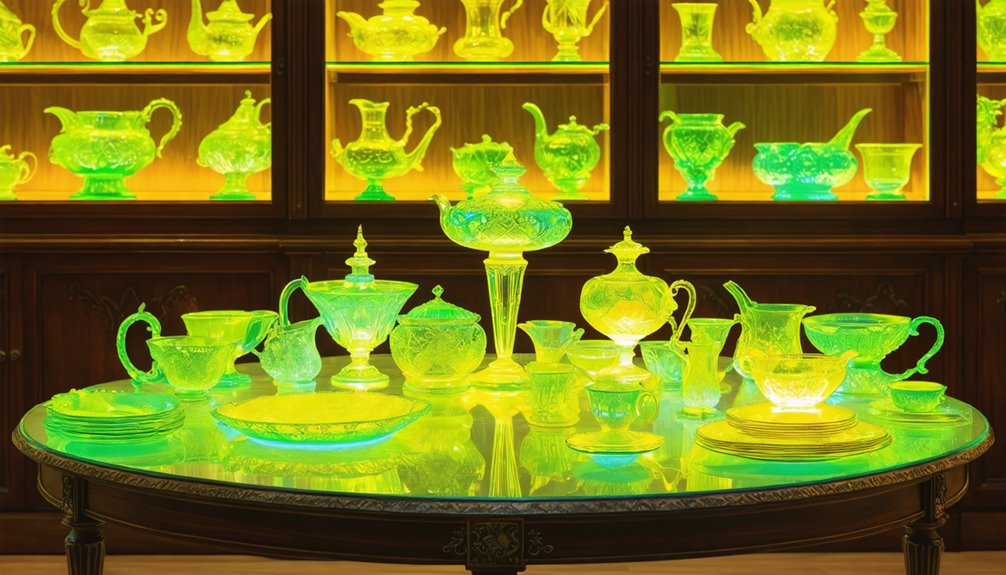
Collecting and Valuation of Antique Uranium Glass Tableware
Uranium glass, often called Vaseline glass, has a fascinating history. Its bright, greenish glow comes from the small amounts of uranium added during production. This glass was first made in the early 19th century. It quickly caught the eye of glassmakers in Europe and America. They used it in a range of items, from decorative pieces to everyday tableware.
Uranium glass, known for its distinctive greenish glow, captivated 19th-century glassmakers who used it widely in decorative and utilitarian objects.
In the late 1800s, uranium glass became popular for its unique luminescence. It was a hit at fairs and exhibitions. Many people were intrigued by its glow under ultraviolet light. The glass wasn’t just pretty; it also had a practical side. It was often used in lamps and other household items. This made it a staple in many homes.
Over time, some manufacturers, like Fenton and Whitefriars, became well-known for their high-quality uranium glass. Their pieces often had stunning patterns and designs. Collectors today value these items for their craftsmanship and history. Although they aren’t as common as they once were, certain rare pieces can reach impressive prices at auctions.
Health concerns about uranium glass have emerged over the years. Some collectors pay close attention to these issues. Safe pieces are certainly more desirable. On the other hand, items that show wear or were used for food service may not attract collectors as much. This affects their value in the market.
In essence, the allure of uranium glass lies not just in its striking appearance but also in its historical roots. Whether for display or collection, it continues to fascinate many.
Frequently Asked Questions
What Was the Purpose of Uranium Glass?
Uranium glass, also known as Vaseline glass, has a fascinating history. Its primary purpose was decorative art. The glassmakers of the 19th and early 20th centuries discovered that adding small amounts of uranium to glass created a vibrant, glowing effect under UV light. This unique characteristic made uranium glass highly sought after for decorative items and tableware.
The glass was not only beautiful but also held historical significance. During the Victorian era, it was popular for making elegant pieces like vases, bowls, and even jewelry. The bright green or yellow hues of uranium glass added a touch of charm to homes. Collectors today appreciate these vintage items for their artistic value and the craftsmanship involved in their creation.
Uranium glass also found use in scientific applications. In the early 20th century, it was sometimes used in laboratories for its radioactive properties. However, the primary focus remained on its aesthetic appeal. Its allure continues to captivate collectors, making it a cherished gem in today’s market.
Why Did They Put Uranium in Plates?
Uranium glass, also known as Vaseline glass, has a rich history that dates back to the 1830s. Makers added uranium to glass to create striking colors and a special glow under ultraviolet light. This unique feature made uranium glass popular among collectors and everyday users alike.
In the early days, uranium glass was used in various items, from plates to decorative objects. The distinct greenish-yellow hue caught the eye of many, and its ability to fluoresce added an intriguing quality. People loved how it looked, and it became a fashionable choice for tableware.
Manufacturers primarily used uranium as a coloring agent. The small amounts of uranium did not pose significant health risks, making it safe for everyday use. Over time, uranium glass became a symbol of the era’s artistic creativity. Collectors now search for these pieces, appreciating both their beauty and historical significance.
Today, uranium glass is celebrated for its unique aesthetic appeal. Many people find joy in collecting these colorful treasures, which tell a story of innovation and style from a bygone time.
Why It Is Safe to Eat Food From the Uranium Glass Plate?
Uranium glass, also known as Vaseline glass, has a fascinating history. It was first popular in the 19th century. Glassmakers discovered that adding uranium to glass produced a vibrant green or yellow hue. This unique color made it attractive for decorative pieces and everyday tableware.
In the early days, uranium glass was widely used. People admired its beauty and the way it glowed under ultraviolet light. At that time, the safety of uranium was not well understood, but the levels of radiation were minimal. Over the years, scientists studied the effects of radiation on health. They found that the radiation emitted from uranium glass is low and not harmful when used properly.
Collectors today appreciate uranium glass for its historic value. Many people enjoy using these beautiful pieces without fear. The modern understanding of radiation has shifted public perception. Most experts agree that occasional use of uranium glass for serving food is safe. The key is to avoid prolonged contact with food and to handle the glass with care.
Why Was Uranium Used in Ceramics?
Uranium glass, often known as Vaseline glass, has a unique history. People used uranium to create this glass because it produced bright colors. These vibrant hues fascinated artists and collectors alike.
In the late 19th and early 20th centuries, uranium was a popular additive in glass production. It provided a striking green or yellow tint. Many artisans used uranium glass to craft beautiful decorative items. These pieces became sought-after collectibles.
At that time, the risks of uranium were not well understood. Manufacturers often used it without considering safety. Today, we know that uranium is radioactive. Regulations now control how it can be used.
Collectors appreciate uranium glass not just for its beauty but for its historical context. It represents a time when materials were used without the caution we exercise today. Each piece tells a story of art, science, and the evolution of safety standards.
Conclusion
Uranium glass, often called Vaseline glass, has a fascinating history rooted in the 19th century. This unique type of glassware, with its striking glow, reflects the design trends of that era. In the 1880s, glassmakers added about 2% uranium oxide to create its famous green and yellow colors. This addition not only enhanced the beauty of the glass but also made it glow under ultraviolet light.
The early uses of uranium glass were diverse. It adorned dining tables and showcased the craftsmanship of the time. Victorians loved its quirky charm and used it for various items, including dishes, vases, and decorative pieces. Each piece tells a story of the period’s creativity and innovation.
Over time, public perception of radioactive materials shifted. This change led to a decline in the production of uranium glass. However, it continues to hold historical significance. Collectors today seek out these pieces, drawn to their unique beauty and the tangible link they provide to the Victorian era.
Uranium glass remains a symbol of the past, captivating enthusiasts who appreciate its artistry and the science behind its creation.
